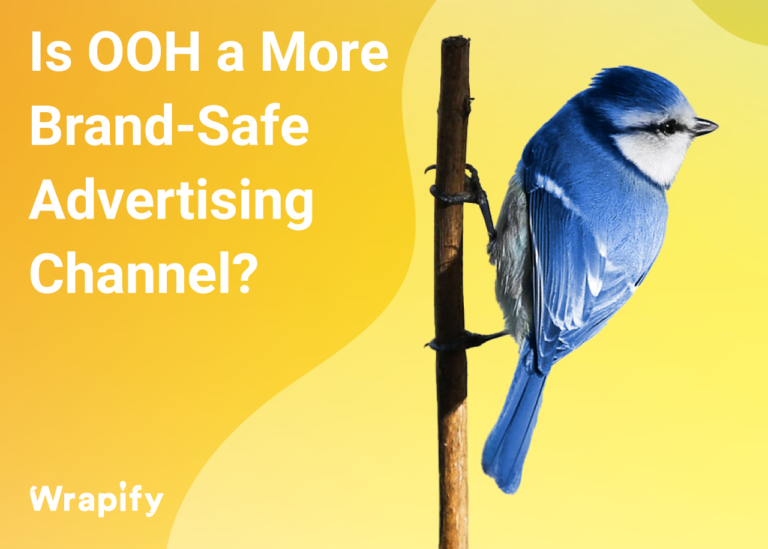Social media is having a moment…and not all in a positive light 😬 It’s been a volatile time for social platforms due to a variety of reasons, including rises of misinformation, personal data collection, and most recently, the drama surrounding Elon Musk’s takeover of Twitter. The blue bird (and corresponding checkmark) has suddenly taken on a different identity.
It’s safe to say that big brands took notice of these changes and started seeking more brand-safe advertising channels for growth. And it’s no coincidence that as the performance of digital ads took a dive, brands started shifting to out-of-home (OOH) as a practical advertising approach.
In Brand-Safe Advertising, Quality Matters
With digital marketing, there is little a brand or marketer can do to improve a brand-safe advertising environment. Since the medium is the message, the medium on which the advertising message appears affects the message.
The unsafe online environment is affecting people and brands more than ever. A report published by the UK-based Reuters Institute revealed worrying fatigue in news and other media consumption on the Internet. The study of over 93,000 respondents in over 46 markets globally concluded that more than half of people who consume content on TV, online news, messaging apps, social media, and search engines had lost faith in content-driven media and brands that advertise on them.
The same study found that more than 80% of consumers said they tend to trust brands that ‘do what is right’ and ‘associate with other brands that do good.’ Consumers prefer to buy from brands with whom they share values, particularly those that help tackle challenges society faces.
Advertising online and in digital media exposes brands to risks of appearing next to fake, inappropriate, or negative content. This magnifies their vulnerability to being associated with toxic brands and content, which could hurt their brand.
Presently, the only way for a brand or marketer to keep its message safe from the effects of unhealthy advertising is to pass its message in a safe environment.
The Future of Advertising is Purposeful Ads
Most media platforms are powered by advertising. As the tastes of advertisers and consumers evolve, purpose-driven media is emerging as the future of advertising. This form of marketing aims to build a deep rapport with consumers. Purposeful advertising appeals to the understanding of the target market and reveals how it will benefit in the long run.
For consumers, purpose-driven marketing is more appealing because it relies less on the frequency of exposure to the message and more on its relevance. As individuals and society at large grow, advertising is becoming less about control and more about promoting diversity, equity, and inclusion. Consumers will lend an ear to a brand they know cares about education, the environment, security, and privacy.
The most notable form of advertising that relies on purposeful ads is OOH advertising. These include traditional advertising outside the consumer’s home, from billboards to vehicle wrappers and everything in between. Some of the top benefits of OOH advertising are that it is not intrusive. The advertising message is location-based, and it is highly effective in instigating consumer engagement.
Big brands that have traditionally relied on content-driven media to advertise gradually realize the benefits of OOH advertising. The main driving force for the shift is the realization that in a world of digital advertising. Brand safety issues are a matter of ‘when’ and not ‘if.’
Every brand should strive to protect its name in a rapidly evolving digital landscape. However, as this demands constant foresight, delicate planning, and collaboration, it is proving to be more costly than ever. Every advertiser must now remain diligent on the platform their message appears. It’s the only way to quickly mitigate the impact on their brand when negatively-purposed messages threaten to besmirch their name.
The Importance of Proactivity in Brand Safety
The platform a brand uses to pass its message, the content the ads are placed next to, and the context of the message affect its truth and identity. A brand that cares about its values and does all it can to align its message accordingly must be proactive in ensuring its brand safety.
As an advertising message is a part of a marketing ecosystem, the platform it appears on must resonate with the target market. OOH advertising targets consumers in their right places with a meaningful and purposeful message. The advertisement can be carefully designed and worded to have a meaningful impact on both the consumers and the advertiser in a reassuring and memorable way. With OOH, the message can be big and bold or small and subtle, but it is intentional.

OOH is a brand-safe and effective approach to modern advertising. In an age of internet turmoil and elevated risks of digital advertising, OOH brings a renewed sense of joy for consumers tired of intrusive ads. Media fatigue is a real problem, and advertising outdoors is a sure way to reassure the target market that a brand cares about them. No brand can afford to underestimate the impact of sharing a message offline and outdoors today.
Next Steps
More brands are already cutting their digital ad budgets and pulling ads from online platforms. This happens mostly after their messages appear in undesirable contexts, often hurting their brand name.
Forward-looking brands stay ahead of the damage by proactively investing in location-based and brand-safe advertisements such as OOH. This is because OOH is safe and real advertising with proven results.
If your brand is not doing this already, do not wait until your brand takes a hit. Visit wrapify.com now to discover how you can promote your brand’s safety with OOH advertising.
